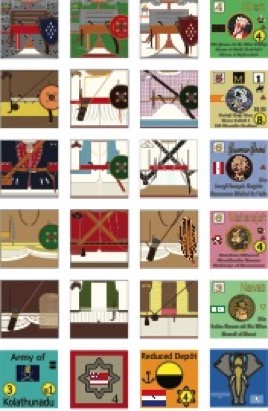The Game
Dreams of Empire is the sixteenth volume in Red Sash Games’ Lace Wars series. It starts a new series examining the wars in India just as the British and French are beginning to think big. Dreams of Empire is set early in that process (1730s and 1740s), and focuses on southern India, at a time when the Europeans are bit-players in the drama. The Mughal Empire's foundations are shaking and the Maratha Confederation is the new rising power. The shockwaves are being felt all over India. Most of the South is part of the imperial frontier, a Wild West (or East) full of warlords, decaying ancient dynasties, adventurers from the North seeking to carve out their own kingdoms, and entire mercenary castes offering their swords to the highest bidder. Only on the Malabar Coast does political life continue its old cycle — one of perpetual violence between a group of closely related rajas. Here, the rising power is the Kingdom of Travancore, bent on resurrecting the Chera Empire of the past with European weapons and European money. The money is no Western loan or aid package. It comes from extortionate export duties on Malabar's famous spice trade. The weapons, too, are offered for pepper. For the Europeans are only here for the same reason as every other foreigner, to buy spice and other rare commodities that they can sell in their homelands for an eye-watering profit.
Dreams of Empire is a two-player game, but because the South is in constant turmoil, with kingdoms switching sides at the drop of a hat, the players do not command grand alliances. Instead, they assume periodic control of that or that kingdom (or trading company) whenever it is given an Objective to attain. By fulfilling such Objectives in the role of 'advisors' or 'condottieri', the players earn Prestige, and the winner is the player with the highest Prestige. Many powers are featured in Dreams of Empire: the Mughals, Marathas, and Hyderabad; Kapada, Sira, Chitradurga, and Mysore; Bednur and Coorg; the Sultanate of Arcot, Madurai, and Tanjore; Kolathunadu, Calicut, Cochin, and Travancore; the East Indies companies of Britain, France, and Holland. Plenty of sultans, rajas, and governors to offer your services to!
Again, because of the chaos of the times, the Grand Campaign scenario is constructed as a sandbox, where all the powers can activate and go neutral repeatedly over the course of several years. There are four Minor Scenarios, too: the Dutch-Travancore War of 1739-1743, the Canarese invasion of Malabar in the 1730s (also featuring Kolathunadu's futile attempts to bring their vassal the Ali Raja back into line), the Madurai Succession Wars of the 1730s, and the First Carnatic War between the British and French. There are also rules to link the last scenario with the Carnatic War naval module in RSG's Sea Lords expansion set, Four Corners.
Components
1) Six map sections, each 22" x 34". Each scenario only requires two maps. The Grand Campaign uses a pair that covers all of southern India and the scenarios use enlarged maps for their respective areas of operation.
2) 840 die cut counters representing the forces of the various kingdoms and trading companies. Scale is 'mixed'. Some counters represent battalions or even smaller groupings while others are brigade-sized formations of varying strengths.
3) Rules, charts, tables, and display cards.
4) An historical commentary.

